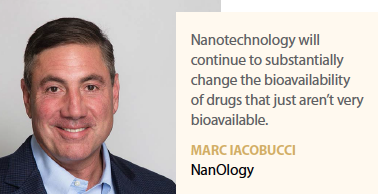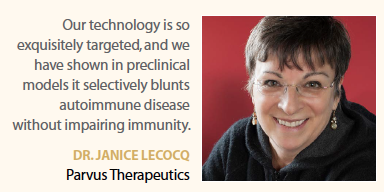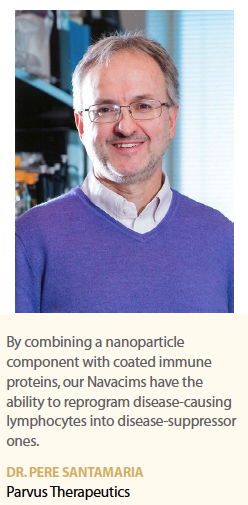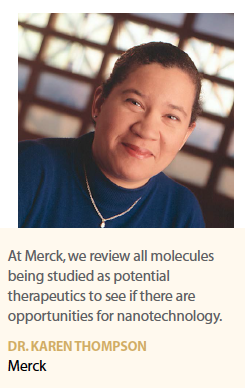The first generation of nanotechnology-based medicines, including nano-based drug delivery systems and nanovectors, improved the safe delivery of therapies that were once toxic. Nanoparticles have also proven to be especially good vehicles to effectively deliver cancer drugs, where many therapies are toxic in high doses, because they can minimize or negate potential off-target effects.
Nano-delivery systems offer a lot of possibilities for patients to receive adequate exposure of molecules that have solubility challenges, says Karen Thompson, Ph.D., senior scientist, Merck.
 Merck’s Emend (aprepitant) is an example. Merck uses a nanoscale milling approach to generate very small granules that are more easily absorbed by the digestive tract. Emend is used in adults to treat nausea and vomiting caused by certain cancer medicines.
Merck’s Emend (aprepitant) is an example. Merck uses a nanoscale milling approach to generate very small granules that are more easily absorbed by the digestive tract. Emend is used in adults to treat nausea and vomiting caused by certain cancer medicines.
“Emend was the first product that we developed using this technology," she says. “This was a case where the molecule itself has poor solubility; even after milling it down to micron particle sizes we had issues with food effect. During the clinical studies, as we were searching for efficacy and adequate exposure, we experimented with a liquid capsule formulation. But even with this formulation, we couldn’t achieve adequate solubility. The nanocrystal formulation helped us to achieve higher exposure of the molecule and minimize food effects."
Now, a new generation of nanomedicines is being developed that go beyond cancer, and they include nanoparticles that generate a therapeutic effect.
Nanomedicine Research
Nanotechnology allows scientists to create, explore, and manipulate materials on a scale measured in nanometers — particles so small that they cannot be seen with a regular microscope. Nanomedicine is an offshoot of nanotechnology and refers to highly specific intervention at the molecular scale for curing diseases or repairing damaged tissues.
The global nanomedicine market was valued at $111.9 billion in 2016 and is projected to reach $261.1 billion by 2023, growing at a CAGR of 12.6% from 2017 to 2023, according to a November 2017 report from Allied Market Research.
Marc Iacobucci, managing director, NanOlogy, believes nanotechnology will continue to substantially change the bioavailability of drugs that just aren’t very bioavailable.
 “Even large molecules can benefit from coating agents or carriers that might allow them to either be orally administered or administered in a way that targets the distribution to the affected area," he says. “This benefit remains and will be one of the great areas of opportunity for nanoparticle technology. Where our technology differs from more traditional nanotechnology is that we are able to produce stable naked submicron particles that are designed to be delivered locally — directly to the site of disease — in a concentrated sustained release form."
“Even large molecules can benefit from coating agents or carriers that might allow them to either be orally administered or administered in a way that targets the distribution to the affected area," he says. “This benefit remains and will be one of the great areas of opportunity for nanoparticle technology. Where our technology differs from more traditional nanotechnology is that we are able to produce stable naked submicron particles that are designed to be delivered locally — directly to the site of disease — in a concentrated sustained release form."
NanOlogy was formed in 2015 through the collaboration of DFB Pharmaceuticals, CritiTech, and US Biotest to advance a submicron particle production technology platform for the treatment of cancer and other serious illnesses. The company’s technology reduces unprocessed paclitaxel and docetaxel API crystals by up to 400 times into patented, stable, naked submicron particles with tremendous surface area and unique geometry.
NanOlogy has developed these submicron particles into sterile injectable, topical, and inhalable products and has a clinical program under way to evaluate these products across multiple indications in cancer and related illnesses. The program includes Phase II clinical trials in ovarian, prostate, and pancreatic cancers, pancreatic cysts, cutaneous metastases, and actinic keratosis under affiliate, Soria. In addition, preclinical studies via nebulized inhalation are under way for the treatment of lung cancer.
“Our technology works through use of supercritical fluid carbon dioxide and sonic energy to make small uniform stable particles," Mr. Iacobucci says. “Essentially, we’re taking the dissolved drug substance, and through sonication, reducing that dissolved drug substance into smaller and smaller droplets that are then precipitated by super critical fluid carbon dioxide into submicron particles that meet strict specifications for mean particle size."
 NanOlogy’s process is unique, he says, because the other ways of making small particles impart static energy charged into the particles, which creates a nonstable powder that can simply clump together and cannot be easily handled for further processing.
NanOlogy’s process is unique, he says, because the other ways of making small particles impart static energy charged into the particles, which creates a nonstable powder that can simply clump together and cannot be easily handled for further processing.
“Our technology doesn’t impart any energy into the small particles so they remain stable in powder form, and we’re able to suspend the medicine in a simple vehicle like saline, which allows for the particles to be delivered locally to tumors," Mr. Iacobucci explains.
The particles themselves are a sustained-release form, which allows the molecules of active ingredient to release at the tumor site for weeks.
In November 2017, the company began enrolling patients for its Phase II trial of NanoPac (nanoparticle paclitaxel) for the treatment of mucinous cystic neoplasms (MCNs) of the pancreas. In December, a pancreatic cancer trial was launched. The company’s clinical trial in actinic keratosis is expected to complete in January 2018.
Nanoparticles as Active Ingredients
Another branch of the new generation of nanomedicine research is investigating the use of the nanoparticle itself as the active ingredient. One company involved in this research is Parvus, which is developing a new class of biological therapeutics called Navacims that are designed to halt autoimmune disease by restoring immune tolerance.
“The nanoparticle enables proteins to acquire function that by themselves cannot mediate," says Pere Santamaria, M.D., Ph.D., founder and chief scientific officer, Parvus Therapeutics. “There is a symbiotic relationship between the nanoparticle and the proteins that we coat onto it; the result is a powerful new biological activity that enables the protein to reprogram disease-causing lymphocytes into disease-suppressor ones."
Dr. Santamaria explains that the resulting nanoparticle-enabled drugs work like finding a needle in the haystack among the many millions and millions of lymphocytes that circulate through the body and bloodstream. In essence, Navacims find the lymphocytes that participate in the autoimmune disease that is to be treated.
“Navacims reprogram these cells into disease-suppressing lymphocytes and trigger their subsequent expansion, setting in motion a cascade of downstream cellular events that amplify the disease-suppressing effect," Dr. Santamaria says. “This action creates a naturally occurring event that clears inflammation in the organ that is being attacked and does so without impairing general immunity."
 Navacims can be tailored to specifically suppress immune responses targeting different tissues. Parvus is conducting preclinical research of two lead drug candidates to take into clinical development for type 1 diabetes.
Navacims can be tailored to specifically suppress immune responses targeting different tissues. Parvus is conducting preclinical research of two lead drug candidates to take into clinical development for type 1 diabetes.
“Navacims were discovered serendipitously," Dr. Santamaria says. “We were trying to understand the mechanisms of inflammation in one single autoimmune disease: type 1 diabetes. We were using nanoparticles displaying a specific type of immune system proteins, called major histocompatibility complex molecules, to selectively “fish" type 1 diabetes-related lymphocytes from the immune system. Unexpectedly, these compounds turned disease-causing lymphocytes into cells having new phenotypic and biological properties, promoting disease suppression. We had no idea that the molecule we had built to carry out curiosity-driven experimentation had such a unique therapeutic activity."
Parvus, a private company founded in 2007, has a collaboration with Novartis for its type 1 diabetes program. Parvus has responsibility for the preclinical, pre-IND studies, and the scale up of Navacim until the filing of the IND, and then Novartis will take the program into the clinic, says Janice LeCocq, Ph.D., chairman and CEO of Parvus Therapeutics.
“We are also looking for another collaboration and venture financing before achieving proof of concept to push a parallel set of indications toward the clinic," she says.
Another company, Selecta, utilizes nanoparticles to target the immune system. The company’s proprietary technology, Synthetic Vaccine Particles (SVP), involves biodegradable nanoparticles that are intended to deliver instructions to the immune system, similar to the way vaccines act.
“Vaccines are often delivered with what’s called an adjuvant, and the adjuvant serves to activate innate immune cells such as dendritic cells," says Takashi Kishimoto, Ph.D., chief scientific officer, Selecta Biosciences. “When dendritic cells become activated, they go on to stimulate an immune response. Our nanoparticle is designed to create the equivalent of a tolerogenic adjuvant. Rather than delivering active ingredients to the site of the disease, we target the immune system and send signals that the biologic should be tolerated.
SEL-212, Selecta’s lead candidate, which is currently in Phase II, is being developed as a monthly treatment consisting of pegsiticase, a potent uric acid lowering uricase enzyme, co-administered with SVP-rapamycin to prevent anti-drug antibodies (ADAs).
“We have conducted a couple of Phase I clinical trials and we have an ongoing Phase II clinical trial in which we show that indeed we can prevent the formation of these antibodies to that enzyme," says Werner Cautreels Ph.D., chairman and CEO of Selecta Biosciences.
Dr. Cautreels says this has important implications for gene therapies. Current gene therapy research uses viral vectors to transfer genetic information. This has the potential to cause the immune system to react, and preclinical models have shown that Selecta SVP technology can prevent this.
The company’s two proprietary gene therapy product candidates, SEL-302 and SEL-313, are being developed for rare inborn errors of metabolism and have the potential to enable repeat administration.
Selecta also is developing an oncology candidate — SEL-403 — that leverages a potent recombinant immunotoxin (LMB-100), which has been in a Phase I program targeting pancreatic cancer and mesothelioma.
Another company exploring this research area is Nanobiotix, which is using nanophysics to target cancer during radiotherapy. The company’s most advanced product, NBTXR3, is a nanoparticle that interacts with radiotherapy, allowing the particle to deliver energy into the cancer cells, which destroys the cancer. NBTXR3 is being studied across seven different clinical trials in 60 different clinical centers across the United States and Europe, involving head and neck patients, sarcoma patients, rectum cancer patients, prostate, liver, and hepatocellular cancer patients.
Additionally, head and neck cancer and rectal cancer clinical trials led by Nanobiotix’s Taiwanese partner, PharmaEngine, are under way in the Asia-Pacific region.
In August 2016, the company filed NBTXR3 for market approval (CE Marking) in Europe for treatment of locally advanced soft tissue sarcoma and other NBTXR3 clinical trials.
“Our first-in-class radio-enhancer product is a one-time injection given before the first day of radiotherapy," says Laurent Levy Ph.D., CEO, Nanobiotix. “The particle has been designed to absorb X-ray, and that improves the dose within the tumor without affecting surrounding healthy tissue."
Dr. Levy says the company will focus next on metastatic lung cancer and relapsed head and neck cancer that has failed or does not respond to checkpoint inhibitors.(PV)

















